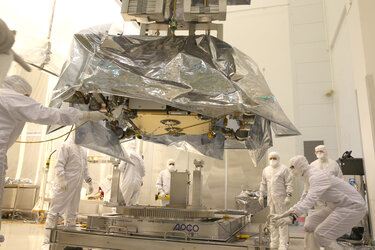Accept all cookies Accept only essential cookies See our Cookie Notice

About ESA
The European Space Agency (ESA) is Europe’s gateway to space. Its mission is to shape the development of Europe’s space capability and ensure that investment in space continues to deliver benefits to the citizens of Europe and the world.
Highlights
ESA - United space in Europe
This is ESA ESA facts Member States & Cooperating States Funding Director General Top management For Member State Delegations European vision European Space Policy ESA & EU Space Councils Responsibility & Sustainability Annual Report Calendar of meetings Corporate newsEstablishments & sites
ESA Headquarters ESA ESTEC ESA ESOC ESA ESRIN ESA EAC ESA ESAC Europe's Spaceport ESA ESEC ESA ECSAT Brussels Office Washington OfficeWorking with ESA
Business with ESA ESA Commercialisation Gateway Law at ESA Careers Cyber resilience at ESA IT at ESA Newsroom Partnerships Merchandising Licence Education Open Space Innovation Platform Integrity and Reporting Administrative Tribunal Health and SafetyMore about ESA
History ESA Historical Archives Exhibitions Publications Art & Culture ESA Merchandise Kids Diversity ESA Brand CentreLatest
Space in Member States
Find out more about space activities in our 23 Member States, and understand how ESA works together with their national agencies, institutions and organisations.
Science & Exploration
Exploring our Solar System and unlocking the secrets of the Universe
Go to topicAstronauts
Missions
Juice Euclid Webb Solar Orbiter BepiColombo Gaia ExoMars Cheops Exoplanet missions More missionsActivities
International Space Station Orion service module Gateway Concordia Caves & Pangaea BenefitsLatest
Space Safety
Protecting life and infrastructure on Earth and in orbit
Go to topicAsteroids
Asteroids and Planetary Defence Asteroid danger explained Flyeye telescope: asteroid detection Hera mission: asteroid deflection Near-Earth Object Coordination CentreSpace junk
About space debris Space debris by the numbers Space Environment Report In space refuelling, refurbishing and removingSafety from space
Clean Space ecodesign Zero Debris Technologies Space for Earth Supporting Sustainable DevelopmentLatest
Applications
Using space to benefit citizens and meet future challenges on Earth
Go to topicObserving the Earth
Observing the Earth Future EO Copernicus Meteorology Space for our climate Satellite missionsCommercialisation
ESA Commercialisation Gateway Open Space Innovation Platform Business Incubation ESA Space SolutionsLatest
Enabling & Support
Making space accessible and developing the technologies for the future
Go to topicBuilding missions
Space Engineering and Technology Test centre Laboratories Concurrent Design Facility Preparing for the future Shaping the Future Discovery and Preparation Advanced Concepts TeamSpace transportation
Space Transportation Ariane Vega Space Rider Future space transportation Boost! Europe's Spaceport Launches from Europe's Spaceport from 2012Latest

ExoMars rover completes environmental tests
Thank you for liking
You have already liked this page, you can only like it once!
The Rosalind Franklin rover of the joint ESA-Roscosmos ExoMars mission completed a series of environmental tests at the end of 2019 at Airbus, Toulouse, France. This included final thermal and vacuum tests where the Rover is heated and cooled to simulate the temperatures of its journey through space and on the surface of Mars. For example, Rosalind Franklin can expect temperatures dropping to –120°C outside, and –50 °C inside the rover once on Mars. It must also be able to operate in less than one hundredth of Earth’s atmospheric pressure – and in a carbon dioxide-rich atmosphere.
Last year the ‘structural and thermal model’ of the rover successfully completed a rigorous environmental test campaign; the latest round of tests subjected the real flight-model to the simulated space environment.
Now the focus moves to final checks on the rover systems. This includes checking the alignment of instruments working together, such as the imaging systems, and a final functional test of the integrated system after the environmental campaign. Once these verifications on the rover are completed, a functional check of the interfaces with the surface platform and descent module that will deliver it safely to the surface of Mars will be performed at Thales Alenia Space, Cannes, France.
The primary goal of the mission is to determine if there is or there has ever been life on Mars, and to better understand the history of water on the planet. The rover will seek out interesting geological locations to examine with its scientific tools and to drill to retrieve underground samples, on a quest to tackle these questions.
The mission is foreseen for launch in the launch window 26 July–11 August 2020 on a Russian Proton-M rocket with a Breeze-M upper stage from Baikonur, Kazakhstan, arriving at Mars 19 March 2021.
-
CREDIT
Airbus -
LICENCE
ESA Standard Licence

ExoMars rover during environmental tests

ExoMars rover leaves Toulouse

ExoMars rover leaves Toulouse

ExoMars rover leaves Toulouse















 Germany
Germany
 Austria
Austria
 Belgium
Belgium
 Denmark
Denmark
 Spain
Spain
 Estonia
Estonia
 Finland
Finland
 France
France
 Greece
Greece
 Hungary
Hungary
 Ireland
Ireland
 Italy
Italy
 Luxembourg
Luxembourg
 Norway
Norway
 The Netherlands
The Netherlands
 Poland
Poland
 Portugal
Portugal
 Czechia
Czechia
 Romania
Romania
 United Kingdom
United Kingdom
 Slovenia
Slovenia
 Sweden
Sweden
 Switzerland
Switzerland

























